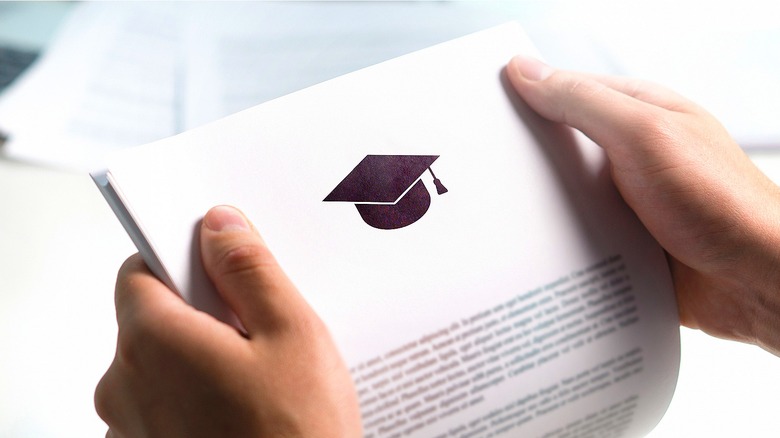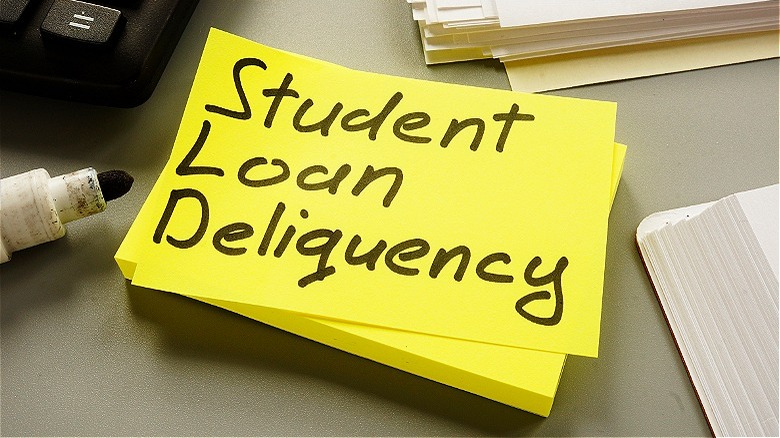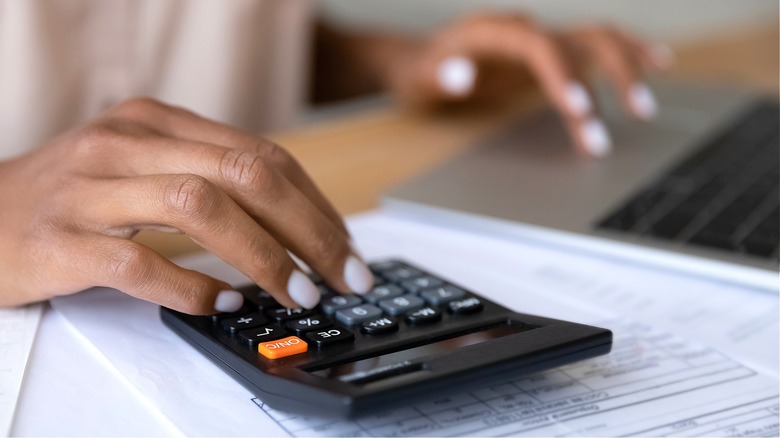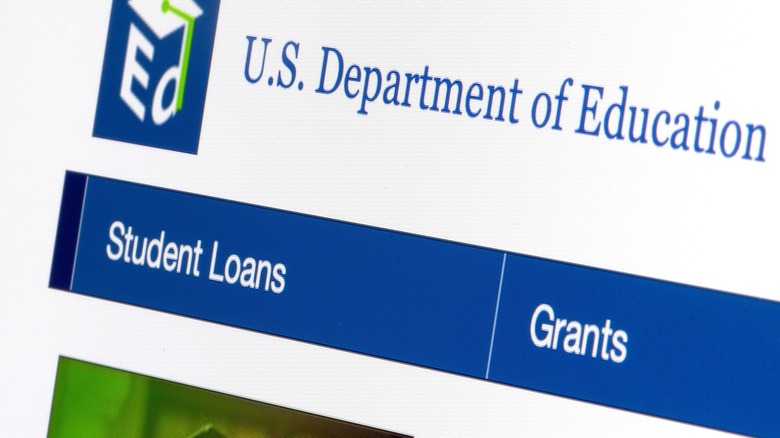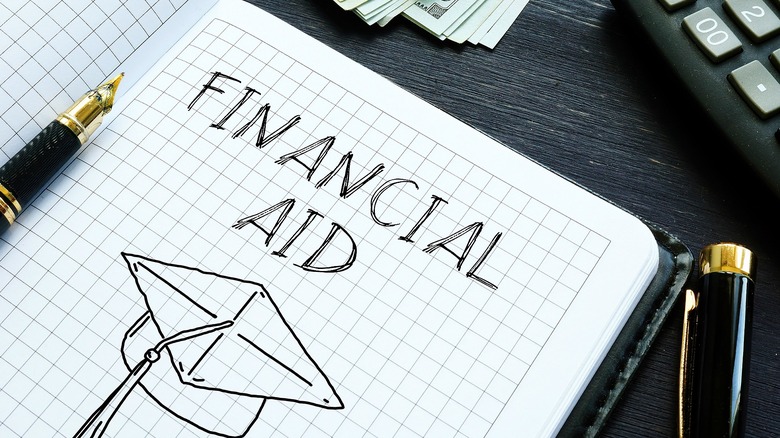What Really Happens If You Don't Pay Off Your Student Loans
As reported by the College Board, 54% of students in the United States leave college with debt. Collectively, student debt — which reached $1.737 trillion in 2023 — is the second-largest kind of debt in the nation, second only to mortgages. Further, repayments of federal student loans resumed in October 2023, meaning those who may have gotten used to the pause in paying off their student loans will now need to begin adjusting their budgets to ensure they don't fall behind.
According to the Education Data Initiative, 91.8% of all student loans are federal student loans. Typically, if a borrower misses payment on their student loan, the account will enter delinquent status. However, because students haven't had to repay their loans for three years, the government created an on-ramp transition period that will last until September 2024. Basically, if you miss a payment during this time, your account will be put into forbearance, not delinquency or default. While interest will continue accruing, your account won't be reported to the credit bureaus or to collections.
This said, after September 2024, students will need to begin repayment in earnest. Failing to pay back student loans could lead to serious and lasting financial consequences. So unless Washington can pass further relief before the 2024 deadline, it's important to be ready and to know what will happen if you don't pay off your student debt.
After missing one payment
Following the on-ramp transition period for federal student loans, if things return to how they were prior to the pause in 2020, then missing a payment will trigger a process that could find your loan in default (after 270 days). The first stage is delinquency; this happens the first day after a payment is missed.
Given that a student loan account goes delinquent after being past due one day, the Education Data Initiative says most people are late at least once, though they don't make it a habit. Once you've paid the past-due amount (or made arrangements), the loan goes back to good standing, but will revert back to delinquent status should you miss another payment.
Your servicer won't report a delinquent account to the credit bureaus until 90 days. So, essentially, you have that amount of time to get your payments back in order. If you miss another payment after returning your account to good standing, everything is reset. So, you'll have another 90 days to get your account right.
After 90 days of being delinquent
Once a student loan reaches 90 days, your servicer will report your account's status to the major credit reporting agencies: Equifax, TransUnion, and Experian. Once this happens, your credit score will drop. The consequence of this? According to Lending Tree, one missed payment can drop a credit score by as much as 180 points. Further, a missed payment remains on your credit report for seven years, though the impact of it lessens over time, especially if you have a string of on-time payments thereafter.
According to the Education Data Initiative, 5% of student loan payments are past due by 90 days- plus, but not yet in default. For federal student loans, a loan won't reach default status until it's past due by 270 days, or nine months. Compare this to private student loans, which can go into default after 90 days (or sooner). As with any loan, if you find yourself falling further behind on payments, contact the servicer and ask about options, such as temporary relief through loan deferment.
After a student loan defaults
Once a federal student loan reaches 270 days, it goes from delinquency to default. Defaulting on a student loan can have lasting consequences, such as losing eligibility for other benefits. If your loan defaults, get in touch with the organization that notified you. As with a delinquent loan, discussing your options is a first step. Ultimately, you have three options to bring an account out of default: 1) loan rehabilitation, 2) loan consolidation, or 3) repayment in full.
Consequences of a student loan going into default are many. For one, the entire balance becomes due; known as acceleration, this clause allows the lender to demand full repayment if conditions are not met. In the case of federal aid, it's when the borrower's account reaches default status. Further, in addition to becoming ineligible for other benefits, the borrower also can't make arrangements, such as deferment or forbearance. The situation is also reported to Equifax, TransUnion, and Experian, which will negatively impact one's credit score even further, making it difficult to qualify for any future credit.
Note that there are a few types of federal student loans, and when each goes into default varies. While it's 270 days past due for the William D. Ford Federal Direct Loan Program and the Federal Family Education Loan Program, the Federal Perkins Loan Program is different. Per the Federal Student Aid website, the holder "... may declare the loan to be in default if you don't make your scheduled payment by the due date."
After the loan is accelerated
According to the Education Data Initiative, 10% of Americans have defaulted on a student loan. Further, there's an average of 7% of student loans in default "at any given time" and a quarter of all borrowers default within their first five years of repayment. As noted earlier, once a student loan goes into default, the loan is accelerated and things start to happen pretty quickly. While you had nine months to reach default status, acceleration puts you on a fast track to resolving the matter.
Most defaulted federal student loans are held by the Department of Education, which means the Department of the Treasury also becomes involved in the collection of funds in the form of withheld federal/state income tax refunds or Social Security benefits. What's more, the government can/will also garnish your wages. As the Federal Student Aid website explains, if so ordered, your employer will need to withhold part of your disposable pay — up to 15%. Not only that, but your workplace will learn about your financial situation in the process.
These actions by the loan's holder will continue until the defaulted student loan is paid back or the loan gets out of default, usually through loan rehabilitation. Loan consolidation becomes an option after the borrower makes three monthly payments in a row, per FSA. When Social Security benefits or tax refunds are withheld — known as a Treasury offset — borrowers will get a "notice of intent to offset," at which time they can make arrangements to avoid the offset from happening (in 65 days from the letter's date).
Paying off your student loan debt
The Education Data Initiative says the average student loan debt is $36,720. Further, the research organization says it takes, on average, 20 years to pay off a student loan. While it's possible to pay a loan off in about half the time, expect monthly payments to be in the $400-plus range, an amount many household budgets are likely unable to accommodate after paying for necessities like taxes, housing, and food.
To this end, the Department of Education offers income-driven repayment (IDR) plans that work with a person's income level. In fact, depending on what a person makes, payment could be as low as $0 a month. There are four different IDR plans; each assesses how much of a person's discretionary income (i.e., income after paying for necessities) can go toward repayment of their loan: the Saving on a Valuable Education (SAVE) Plan (10%), the Pay As You Earn (PAYE) Repayment Plan (10%), the Income-Based Repayment (IBR) Plan (10% to 15%), and the Income-Contingent Repayment (ICR) Plan (20%).
These plans also factor in the size of your family, so the monthly payments should be more in line with what you can afford (versus what you still owe). Borrowers who believe they won't be able to make their regular student loan payments on time and feel they're at risk of defaulting should look into IDR plans as a remedy. The consequences of not paying off student loans, and defaulting, can last for years.
